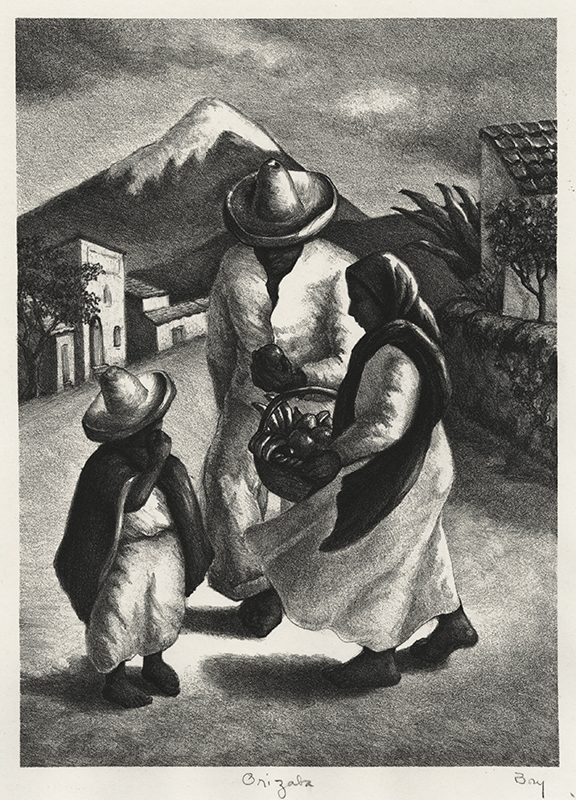Orizaba is a lithograph created in 1944 by American artist Edith Bry. It is pencil signed and titled in the lower margin. Orizaba was published by Associated American Artists and the reference is AAA 587. It was printed on an ivory wove paper in an edition of probably 250 impressions and the image measures 12-5/16 x 8-13/16 inches.
This is a beautifully rendered lithograph illustrates a snippet of the slow-paced daily life in the Mexican city of Orizaba. The woman with the basket might be selling fruit from her garden or sharing her bounty as she heads to market. This human interchange is overlooked by Pico de Orizaba, also known as Citlaltépetl. This is an active stratovolcano and is the highest mountain in Mexico. It is on the border between the states of Veracruz and Puebla and is part of the Pico de Orizaba National Park.
Edith Bry, painter, printmaker, assemblage and mosaic artist, was born 30 November 1889 to Louis and Melanie Bry in St. Louis, Missouri. Her family relocated to New York City around 1906, where Louis Bry opened a successful clothing manufacturing company with a relative. The success of the company allowed her family to travel to Europe before the outbreak of World War I. Visits to museums in Paris and Madrid inspired Edith to pursue art and she began teaching herself how to draw by copying the postcards she brought home.
After graduating from high school in 1917, Bry studied for two years at the Art Students League in New York. Her instructors included Alexander Archipenko, J. Alden Weir, Winold Reiss, Charles Locke, and Guy Pène du Bois. With the end of World War I, she traveled to Germany and studied briefly with Hermann Struck and Siegfried Laboschin. On her return to the U.S., she continued her studies with private lessons from Abe Rattner.
In 1927, Bry had a solo show of
abstractions and portraits in a gallery in Corsicana, Texas, and the following
year two of her works were included in a show at the Opportunity Gallery in the
Art Center in New York. She married Maurice Benjamin in 1929 and they had one
son, who they named Bry Benjamin. Together with architect Ely Jacques Kahn, Edith
helped design an Art Deco-style apartment which is considered one of the best-preserved
examples of the style on the east coast. She joined the National Association of
Women Painters and Sculptors in 1934, and in 1935 she held a solo exhibition of
drawings at the National Association's Argent Galleries to critical
acclaim.
As the Second World War approached, Bry was involved in organizing fundraisers
for overseas relief efforts and, in 1938, she spearheaded the sale of 130 donated
works of art to help European Jews escape Nazi Germany. Her lithograph Exiled was exhibited at the Metropolitan
Museum of Art in 1940. Despite criticism by the Los Angeles Times as to its "grim" nature,
the work was met with praise. Bry joined the artists' advocacy group, the
Federation of Modern Painters and Sculptors, in 1941 and continued to exhibit
throughout the war while also volunteering her time teaching art to war-wounded
soldiers and painting realistic irises for artificial eyes.
After the war Bry became less focused on representation and more on capturing emotion, creating landscapes drenched in light and color and working in new mediums such as fused glass, enamel, and collage. She traveled globally, visiting Mexico, Central and South America, Spain, and the African continent. In the 1960s and '70s she focused on fused glass religious pieces.
Bry was a member of and exhibited with the National Association of Women Painters and Sculptors, the Federation of Modern Painters and Sculptors, and the Studio Guild of New York. She was included in the 1940-41 Annual Exhibition of Contemporary American Painting at the Whitney Museum of American Art. Her work was also exhibited at the Opportunity Gallery, the G.R.D. Gallery, the Argent Galleries, and the Grant Gallery, all in New York.
Edith Bry’s work is represented in the Georgia Museum of Art, University of Georgia, Athens; the Indianapolis Museum of Art, Indiana; the Metropolitan Museum of Art and the New York Public LIbraray, New York; the Hunter Museum of Art, Chattanooga, Tennessee; and the Library of Congress and the National Gallery of Art, Washington, D.C.
In 1983, a retrospective of Edith Bry’s work was mounted at the Loeb Student
Art Center in New York. She continued to live and work in New York until her
death on 19 January 1991.



